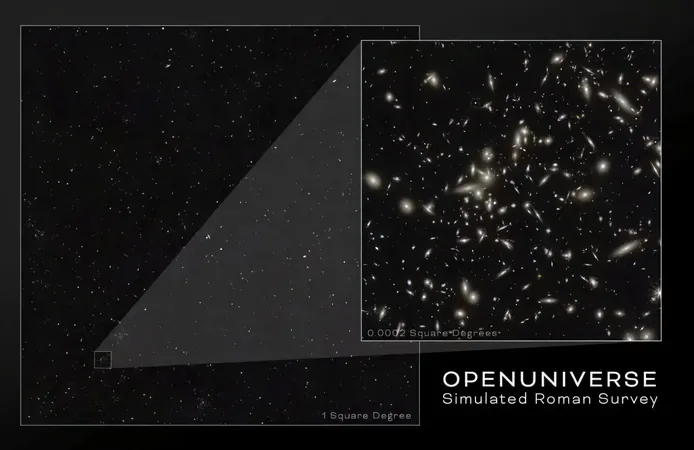
Dive into the Cosmos: NASA's Roman Space Telescope Prepares to Unveil the Universe's Secrets with Stunning Simulations
2025-01-14
Author: Yu
Introduction
Astronomers are making waves in the field of cosmic exploration with over a million simulated images that showcase how the universe will appear when observed by NASA's highly anticipated Nancy Grace Roman Space Telescope. These groundbreaking previews are set to aid scientists in fulfilling Roman's diverse scientific missions, potentially unlocking answers to some of the universe's most perplexing questions.
The Simulation Project
Michael Troxel, an associate professor of physics at Duke University, spearheaded the ambitious simulation project. "Using a supercomputer, we created a synthetic universe, tracing the journey of countless photons from cosmic objects straight to Roman's detectors," Troxel explained. This unprecedented project, dubbed OpenUniverse, harnessed the power of the now-retired Theta supercomputer at the Department of Energy’s Argonne National Laboratory. In just nine days, it accomplished what would normally take over 6,000 years on a conventional computer.
Implications of the Data
The implications of this vast 400-terabyte dataset extend beyond Roman; it also offers insights into observations from the Vera C. Rubin Observatory and simulated scenarios from the European Space Agency’s (ESA) Euclid mission, which includes contributions from NASA. Scientists have already made this invaluable data available, with Rubin's and Euclid's datasets soon to follow.
Scope of the Simulations
By employing state-of-the-art models that incorporate the universe's underlying physics, astronomers made the simulated images cover an impressive 70 square degrees—an area equivalent to more than 300 full moons—and span over 12 billion years of cosmic history. This expansive scope provides a glimpse into the capabilities of upcoming telescopes in tackling some of the universe's greatest mysteries.
Exploring Cosmic Mysteries
Among the puzzles to be explored are the enigmatic phenomena of dark energy, thought to be accelerating the universe's expansion, and dark matter, which remains invisible save for its gravitational effects on visible matter. By analyzing the simulated universe's 100 million synthetic galaxies, scientists aim to uncover insights into the developmental processes of galaxies and galaxy clusters over cosmic time.
Dynamic Visualizations
In an exciting twist, the team has generated dynamic visualizations, or "movies," that depict star explosions illuminating the synthetic cosmos like celestial fireworks. Such starbursts will enable researchers to chart the expansion of the simulated universe, paving the way for further discoveries.
Handling Incoming Data
As data pours in from the Roman Space Telescope, astronomers will utilize OpenUniverse as a foundational testbed for an alert system. This system will notify observers when significant cosmic events occur, enabling researchers to track the associated light and study these fleeting phenomena. Given that Roman is expected to generate an overwhelming amount of data, teams are actively developing machine-learning algorithms to efficiently filter and analyze this cosmic information.
The Challenge of Data Interpretation
"The challenge lies in determining whether an observed phenomenon is a unique type of supernova crucial for mapping universal expansion or simply another occurrence that provides little theoretical value," explained Alina Kiessling, principal investigator of OpenUniverse at NASA's Jet Propulsion Laboratory (JPL).
Upcoming Telescope Operations
While ESA’s Euclid spacecraft is already scanning the cosmos, the Vera C. Rubin Observatory is preparing to commence operations later this year, and Roman is expected to launch by May 2027. The simulations not only help researchers plan future observations but also ensure they are equipped to handle the impending data surge.
Roman's Observational Power
"The Roman mission will surpass all prior efforts in infrared and optical observations," Troxel remarked. "For one of Roman's surveys, observations that would take Hubble or the James Webb Space Telescope around a thousand years can be completed in less than a year."
Excitement for Discoveries
As scientists anticipate the wealth of discoveries that Roman will unveil, Kiessling conveyed excitement about the potential for groundbreaking, award-winning research. "The mission will illuminate aspects of the universe's expansion, create three-dimensional maps of galaxies, and reveal intricate details about star formation— all of which we have already begun to simulate."
Validating Predictions
Once Roman is operational, astronomers plan to engage in a cosmic "spot the difference" challenge, comparing real observations with their simulations to validate their predictions. Any discrepancies might hint at new physics operating outside current cosmological theories.
The Role of Simulations
"If we uncover something that deviates from accepted models, it will be crucial to verify whether we are observing new physics or misinterpreting the data," emphasized Katrin Heitmann, a cosmologist at Argonne National Laboratory. "Simulations play an essential role in helping us understand the cosmos."
Conclusion
Stay tuned as we prepare for a new era of astrophysical revelations that could change our understanding of the universe forever!


 Brasil (PT)
Brasil (PT)
 Canada (EN)
Canada (EN)
 Chile (ES)
Chile (ES)
 Česko (CS)
Česko (CS)
 대한민국 (KO)
대한민국 (KO)
 España (ES)
España (ES)
 France (FR)
France (FR)
 Hong Kong (EN)
Hong Kong (EN)
 Italia (IT)
Italia (IT)
 日本 (JA)
日本 (JA)
 Magyarország (HU)
Magyarország (HU)
 Norge (NO)
Norge (NO)
 Polska (PL)
Polska (PL)
 Schweiz (DE)
Schweiz (DE)
 Singapore (EN)
Singapore (EN)
 Sverige (SV)
Sverige (SV)
 Suomi (FI)
Suomi (FI)
 Türkiye (TR)
Türkiye (TR)
 الإمارات العربية المتحدة (AR)
الإمارات العربية المتحدة (AR)